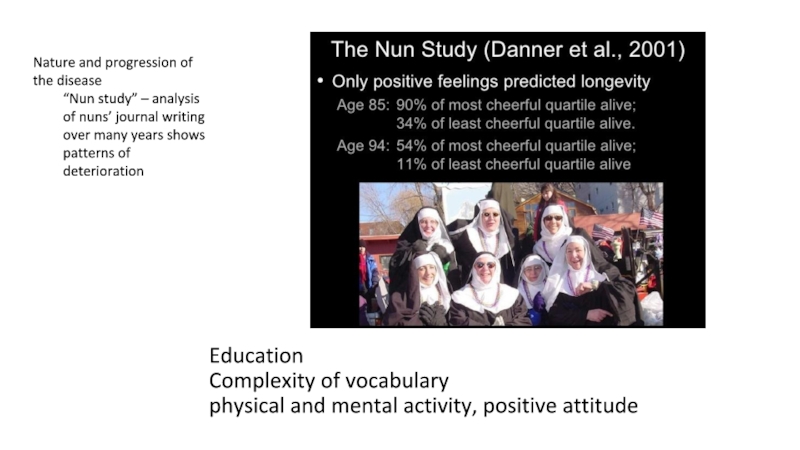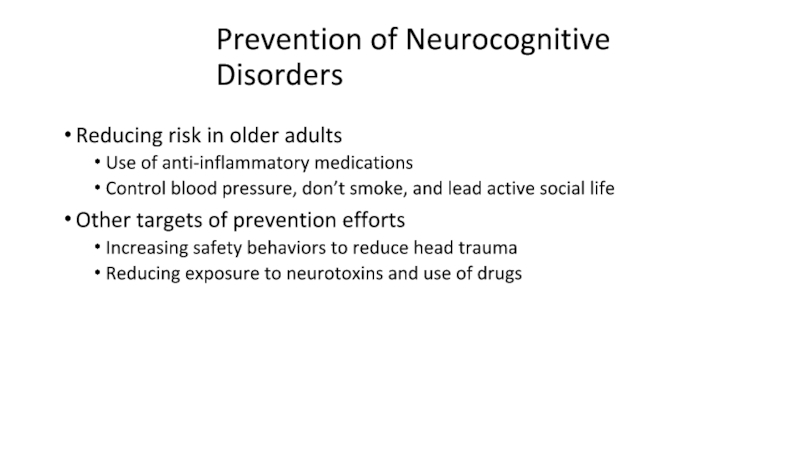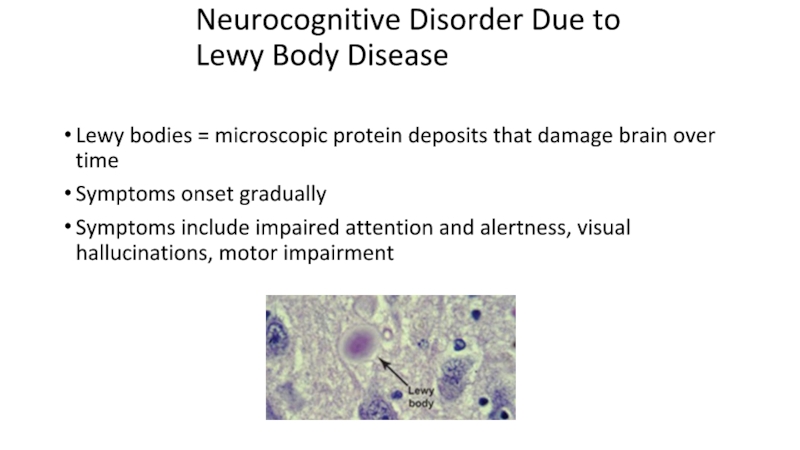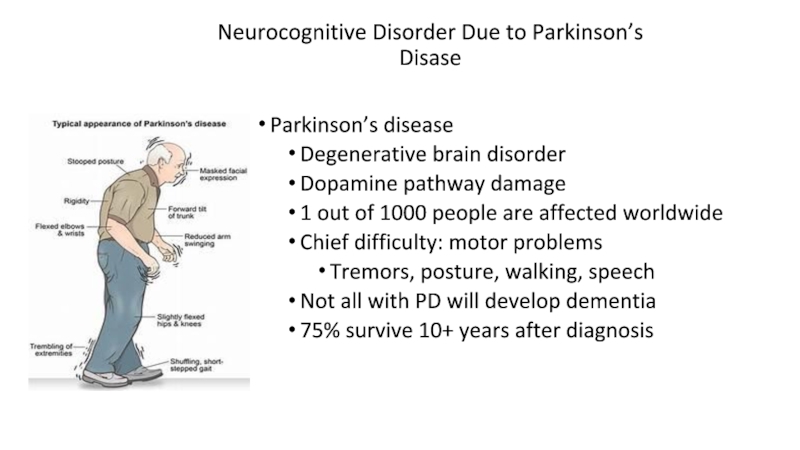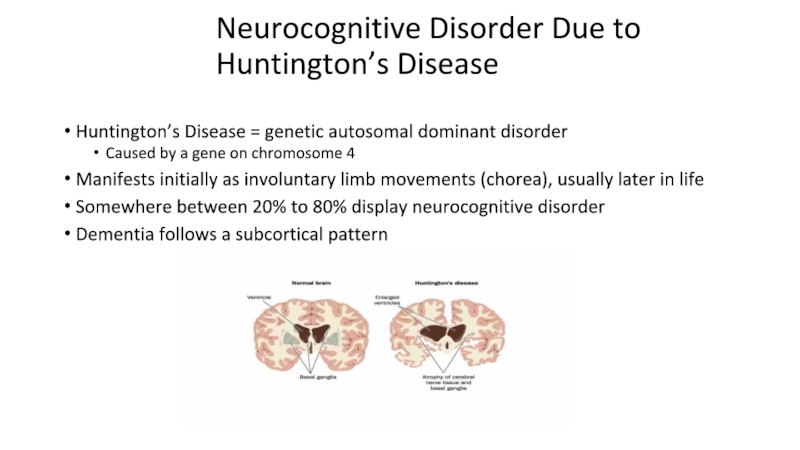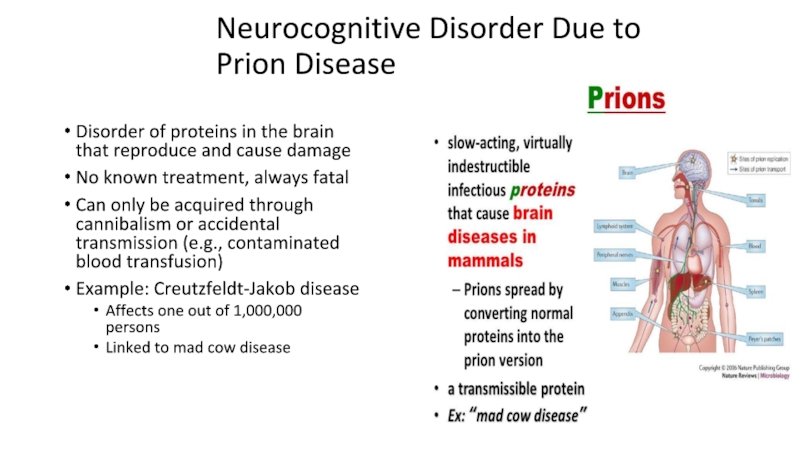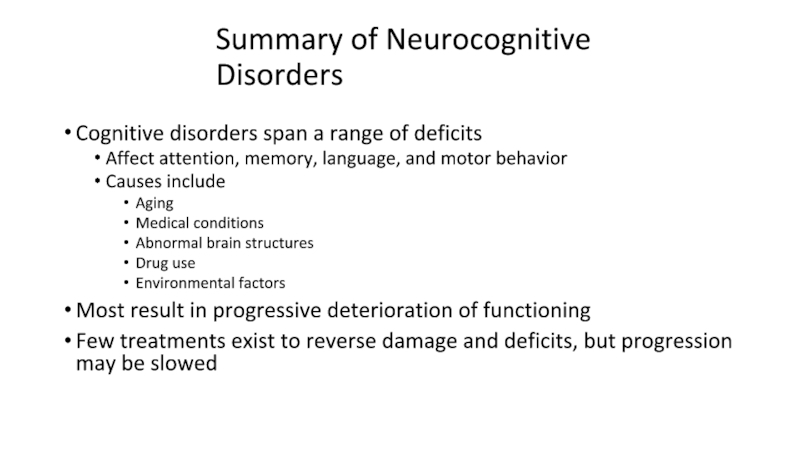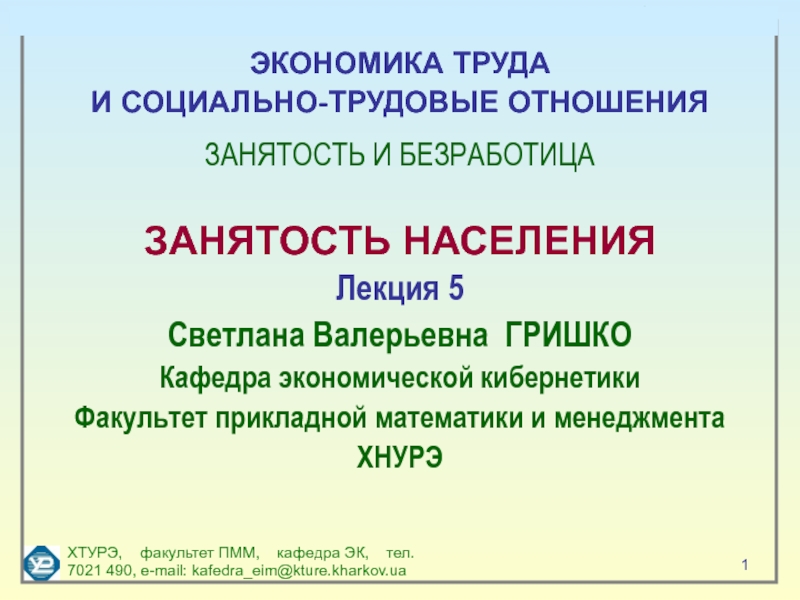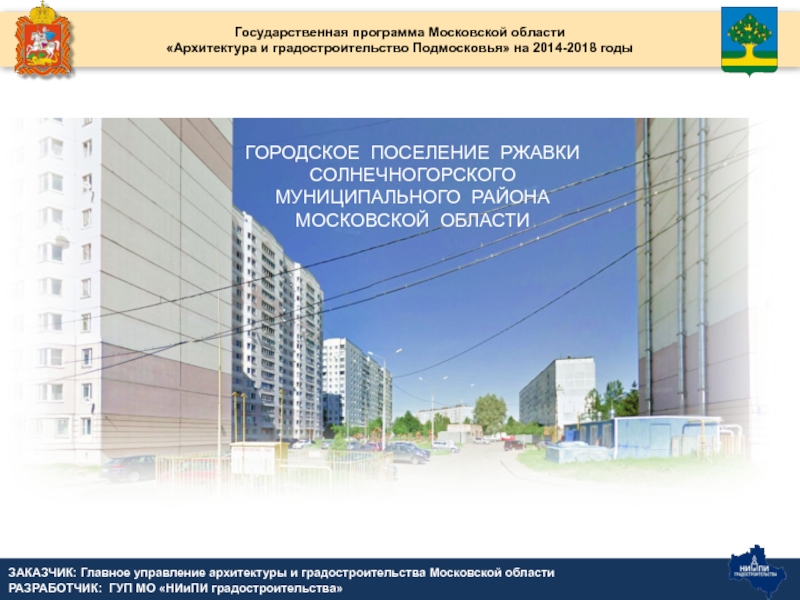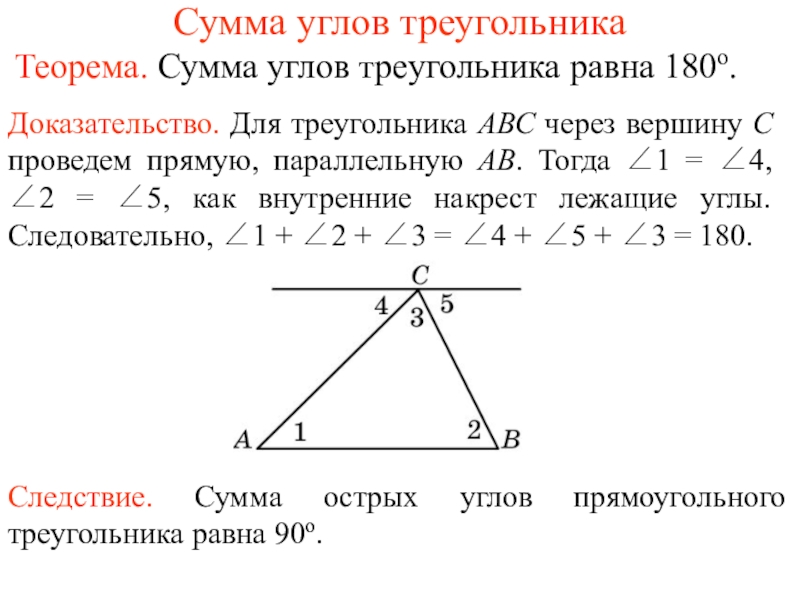Слайд 1Chapter 15
Neurocognitive Disorders
Слайд 2Outline
Delirium
Clinical Description and Statistics
Treatment and Prevention
Major and Mild Neurocognitive Disorders
Clinical
Description and Statistics
Neurocognitive Disorder Due to Alzheimer’s Disease
Vascular Neurocognitive Disorder
Other
Medical Conditions That Cause Neurocognitive Disorder
Substance/Medication-Induced Neurocognitive Disorder
Causes of Neurocognitive Disorder
Treatment and Prevention
Слайд 5Memory Quiz
Which color is on top of a stoplight?
Whose
image is on a penny?
Is he wearing a tie?
What five words besides “In God We Trust” appear on most U.S. coins?
When water goes down the drain, does it swirl clockwise or counterclockwise?
What letters, if any, are missing on a telephone dial?
Слайд 6Which color is on top of a stoplight? (Answer: red)
Whose
image is on a penny? (Answer: Lincoln);
Is he wearing
a tie? (Answer: yes, a bow tie)
What five words besides “In God We Trust” appear on most U.S. coins? (Answer: United States of America and Liberty)
When water goes down the drain, does it swirl clockwise or counterclockwise? (Answer: counterclockwise in the Northern Hemisphere; clockwise in the Southern Hemisphere)
What letters, if any, are missing on a telephone dial? (Answer: Q, Z)
Слайд 7Neurocognitive Disorders: An Overview
Affect learning, memory, and consciousness
Most develop later
in life
Types of neurocognitive disorders
Delirium – temporary confusion and disorientation
Major
or mild neurocognitive disorder – broad cognitive deterioration affecting multiple domains
Amnestic – refers to problems with memory that may occur in neurocognitive disorders
Shifting DSM perspectives
From “organic” mental disorders to “cognitive” disorders
Broad impairments in cognitive functioning
Cause profound changes in behavior and personality
Thus, although some may consider these to be general medical conditions, often best treated by mental health professionals
Слайд 8Delirium: An Overview
Nature of delirium
Central features – impaired consciousness
and cognition
Develops rapidly over several hours or days
Appear confused, disoriented,
and inattentive
Marked memory and language deficits
Designer drugs such as Ecstasy, “Molly,” and “bath salts” can cause substance-induced delirium
Symptoms were written more than 2,400 years ago
Слайд 9Delirium: An Overview, Continued
Facts and statistics
Affects up 20% of adults
in acute care facilities (e.g., ER)
More prevalent in certain
populations, including:
Older adults
Those undergoing medical procedures
AIDS patients and cancer patients
People in hospitals/critical care
Full recovery often occurs within several weeks
Слайд 10Medical Conditions Related to Delirium
Medical conditions
Dementia (50% of cases
involve temporary delirium)
Drug intoxication, poisons, withdrawal from drugs
Infections
Head injury and
several forms of brain trauma
Sleep deprivation, immobility, and excessive stress
Слайд 11Treatment and Prevention of Delirium
Treatment
Attention to underlying causes
Psychosocial interventions
Reassurance/comfort,
coping strategies, inclusion of patients in treatment decisions
Prevention
Address proper medical
care for illnesses, proper use, and adherence to therapeutic drugs
Слайд 12Major and Mild Neurocognitive Disorders
Nature of dementia
Gradual deterioration of brain
functioning
Deterioration in judgment and memory
Deterioration in language / advanced cognitive
processes
Has many causes and may be irreversible
Слайд 13Major and Mild Neurocognitive Disorders: DSM Criteria
Major neurocognitive disorder:
The
new DSM-5 term for dementia
Individual is not able to function
independently
Mild neurocognitive disorder:
New DSM-5 classification for early stages of cognitive decline
Individual is able to function independently with some accommodations (e.g., reminders/lists)
Слайд 14Major Neurocognitive Disorder:
DSM-5
DSM-5 criteria
One or more cognitive deficits
that represent a decrease from previous functioning
complex attention,
executive function,
learning and memory,
language,
perceptual-motor,
social cognition
Interfere with daily independent activities
Слайд 15Major Neurocognitive Disorder Prevalence and Statistics
Prevalence and statistics
New case
identified every 7 seconds
5% prevalence in adults 65+; 20%
prevalence in adults 85+
5 million people
Methodology for estimating number of those suffering from major neurocognitive disorder has resulted in diverging numbers
Dramatic rise in Alzheimer’s predicted through 2050; more people expected to live > 85 years
Слайд 16Major Neurocognitive Disorder: Early Stages
Initial stages
Memory and visuospatial skills impairments
Facial
agnosia – inability to recognize familiar faces
Other symptoms
Delusions, apathy, depression,
agitation, aggression
Later stages
Cognitive functioning continues to deteriorate
Total support is needed to carry out day-to-day activities
Increased risk for early death due to inactivity and onset of other illnesses
Слайд 17DSM-5 Types of Major and Mild Neurocognitive Disorder
Due to Alzheimer’s
Disease
Frontotemporal
Vascular
With Lewy bodies
Due to traumatic brain injury
Substance/medication induced
Due to HIV
infection
Due to prion disease
Due to Parkinson’s Disease
Due to Huntington’s disease
Due to another medical condition
Due to multiple etiologies
Unspecified
Слайд 18Neurocognitive Disorder Due to Alzheimer’s Disease
Accounts for nearly half of
neurocognitive disorders
Clinical Features
Typically develop gradually and steadily
Memory, orientation, judgment, and
reasoning deficits
Additional symptoms may include
Agitation, confusion, or combativeness
Depression and/or anxiety
Слайд 19Causes of Neurocognitive Disorder:
The Example of Alzheimer’s Disease, Continued
Multiple
genes are involved in Alzheimer’s disease
Include genes on chromosomes 21,
19, 14, 12
Chromosome 14
Associated with early onset Alzheimer’s
Chromosome 19
Associated with late onset Alzheimer’s
Слайд 20Causes of Neurocognitive Disorder:
The Example of Alzheimer’s Disease, Part
3
Deterministic genes
Rare genes that inevitably lead to Alzheimer’s
Beta-amyloid precursor gene
Presenilin-1
and Presenilin-2 genes
Susceptibility genes
Make it more likely but not certain to develop Alzheimer’s
Слайд 21PET Scans of Alzheimer’s Vs. Normal Brain
Слайд 22Causes of Neurocognitive Disorder:
The Example of Alzheimer’s Disease
Features of
brains with Alzheimer’s disease
Neurofibrillary tangles (strandlike filaments)
Amyloid plaques (gummy deposits
between neurons)
Brains of Alzheimer’s patients tend to atrophy
Слайд 23Alzheimer’s Disorder: Extent of Deficits
Range of cognitive deficits
Aphasia – difficulty
with language
Apraxia – impaired motor functioning
Agnosia – failure to recognize
objects
Difficulties with
Planning, Organizing
Sequencing
Abstracting information
Слайд 24Neurocognitive Disorder Due to Alzheimer’s Disease : Statistics
Early and later
stages = slow
During middle stages = rapid
Post-diagnosis survival
= 8 years
Onset = 60s or 70s (“early onset” = 40s to 50s)
50% of the cases of neurocognitive disorder result from Alzheimer’s disease
Слайд 25Lisa Genova: Cognitive reserve
Cognitive reserve also indicates a resilience to neuropathological
damage, but the emphasis here is in the way the
brain uses its damaged resources. It could be defined as the ability to optimize or maximize performance through differential recruitment of brain networks and/or alternative cognitive strategies.
Слайд 26Neurocognitive Disorder Due to Alzheimer’s Disease : Prevalence
Prevalence
More common in
less educated individuals
More educated individuals decline more rapidly after onset;
this suggests that education provides a buffer period of better initial coping
Slightly more common in women
Possibly because women lose estrogen as they age; estrogen may be protective
Слайд 27Graph of Predicted Alzheimer’s Incidence
[INSERT Figure 15.1 HERE, p. 548]
Слайд 28Education
Complexity of vocabulary
physical and mental activity, positive attitude
Nature and progression
of the disease
“Nun study” – analysis of nuns’ journal writing
over many years shows patterns of deterioration
Слайд 29Vascular Neurocognitive Disorder
Caused by blockage or damage to blood vessels
Second
leading cause of neurocognitive disorder after Alzheimer’s disease
Onset is often
sudden (e.g., stroke)
Patterns of impairment are variable
The symptoms relate to the area of the brain damaged.
Most require formal care in later stages
Слайд 30Vascular Neurocognitive Disorder: Features
Features
Cognitive disturbances – identical to dementia
Obvious neurological
signs of brain tissue damage
Prevalence 1.5% in people 70 to
75 and 15% for people over 80
Risk slightly higher in men
Слайд 31Vascular Neurocognitive Disorder
Caused by blockage or damage to blood vessels
Second
leading cause of neurocognitive disorder after Alzheimer’s disease
Onset is often
sudden (e.g., stroke)
Patterns of impairment are variable
Most require formal care in later stages
Слайд 32Prevention of Neurocognitive Disorders
Reducing risk in older adults
Use of anti-inflammatory
medications
Control blood pressure, don’t smoke, and lead active social life
Other
targets of prevention efforts
Increasing safety behaviors to reduce head trauma
Reducing exposure to neurotoxins and use of drugs
Слайд 33Neurocognitive Disorder Due to Lewy Body Disease
Lewy bodies = microscopic
protein deposits that damage brain over time
Symptoms onset gradually
Symptoms include
impaired attention and alertness, visual hallucinations, motor impairment
Слайд 34Neurocognitive Disorder Due to Parkinson’s Disase
Parkinson’s disease
Degenerative brain disorder
Dopamine
pathway damage
1 out of 1000 people are affected worldwide
Chief difficulty:
motor problems
Tremors, posture, walking, speech
Not all with PD will develop dementia
75% survive 10+ years after diagnosis
Слайд 35Neurocognitive Disorder Due to Huntington’s Disease
Huntington’s Disease = genetic
autosomal dominant disorder
Caused by a gene on chromosome 4
Manifests
initially as involuntary limb movements (chorea), usually later in life
Somewhere between 20% to 80% display neurocognitive disorder
Dementia follows a subcortical pattern
Слайд 36Neurocognitive Disorder Due to Prion Disease
Disorder of proteins in
the brain that reproduce and cause damage
No known treatment, always
fatal
Can only be acquired through cannibalism or accidental transmission (e.g., contaminated blood transfusion)
Example: Creutzfeldt-Jakob disease
Affects one out of 1,000,000 persons
Linked to mad cow disease
Слайд 37Summary of Neurocognitive Disorders
Cognitive disorders span a range of deficits
Affect
attention, memory, language, and motor behavior
Causes include
Aging
Medical conditions
Abnormal
brain structures
Drug use
Environmental factors
Слайд 38Summary of Neurocognitive Disorders
Cognitive disorders span a range of deficits
Affect
attention, memory, language, and motor behavior
Causes include
Aging
Medical conditions
Abnormal
brain structures
Drug use
Environmental factors
Most result in progressive deterioration of functioning
Few treatments exist to reverse damage and deficits, but progression may be slowed
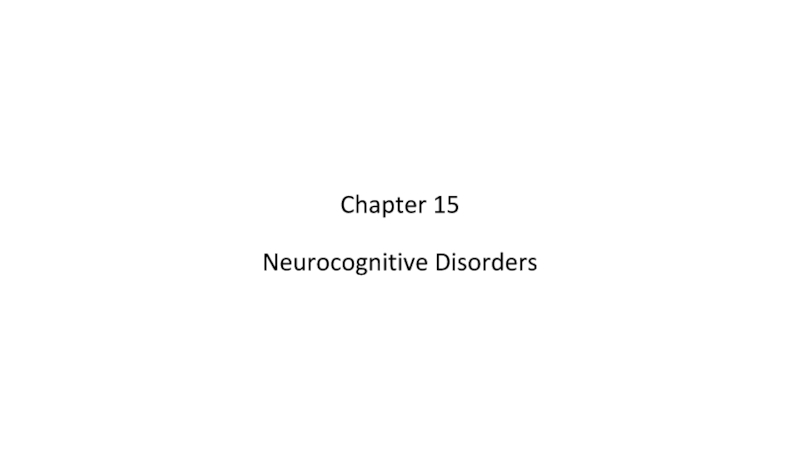



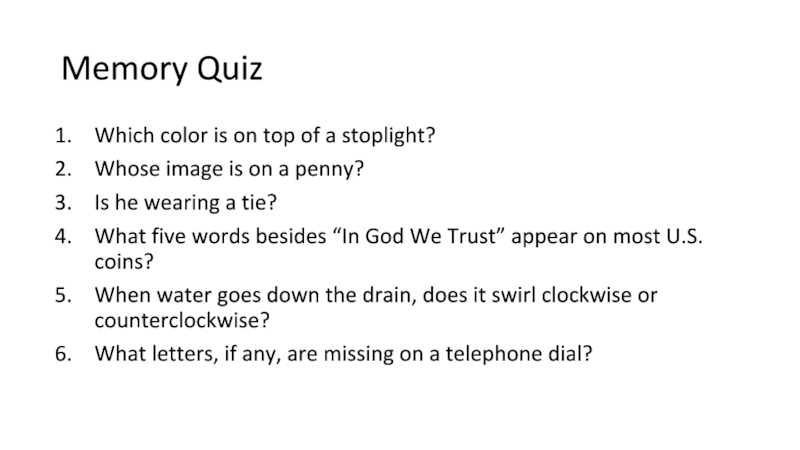
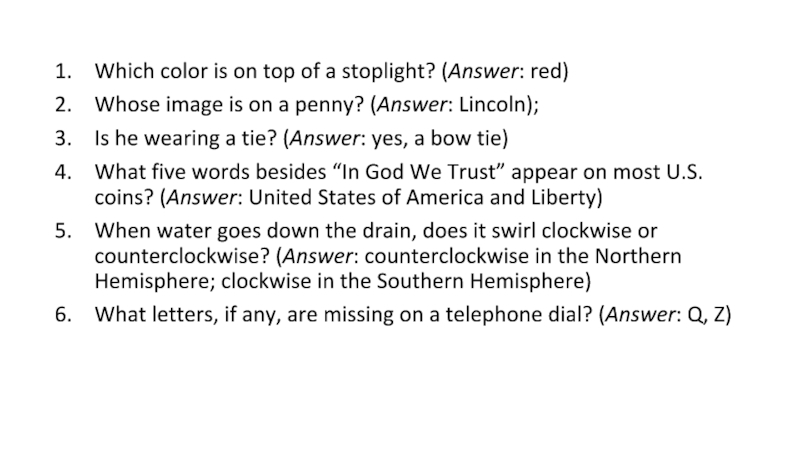
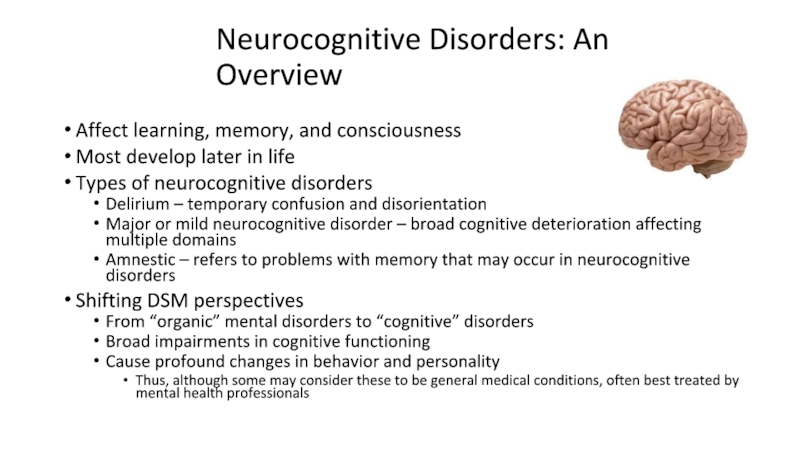


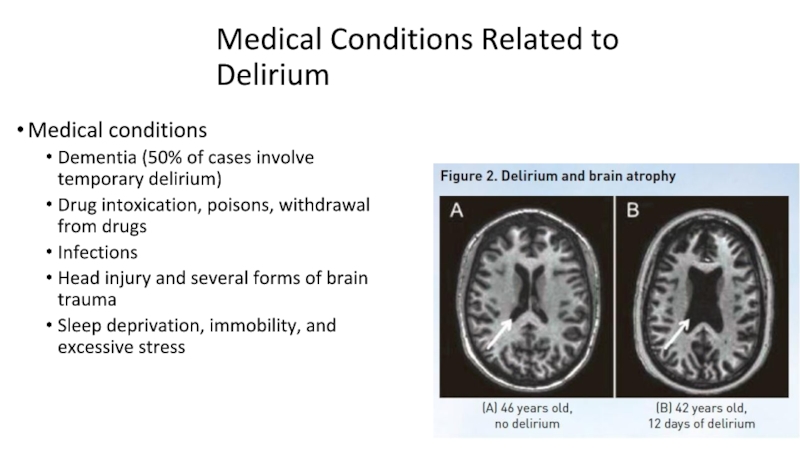
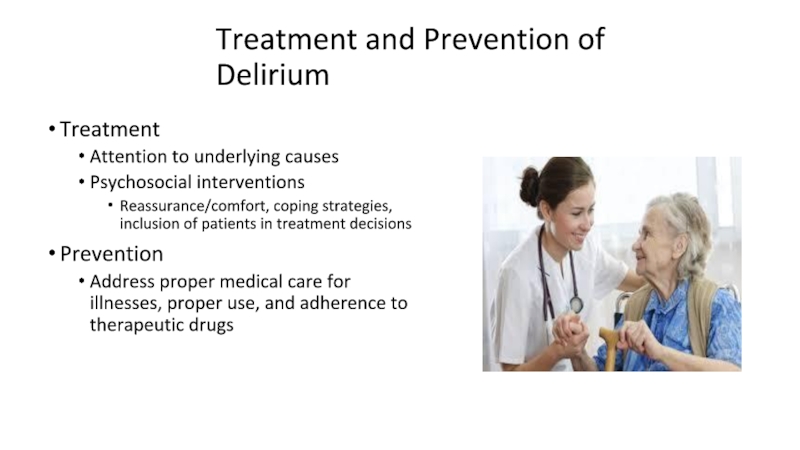
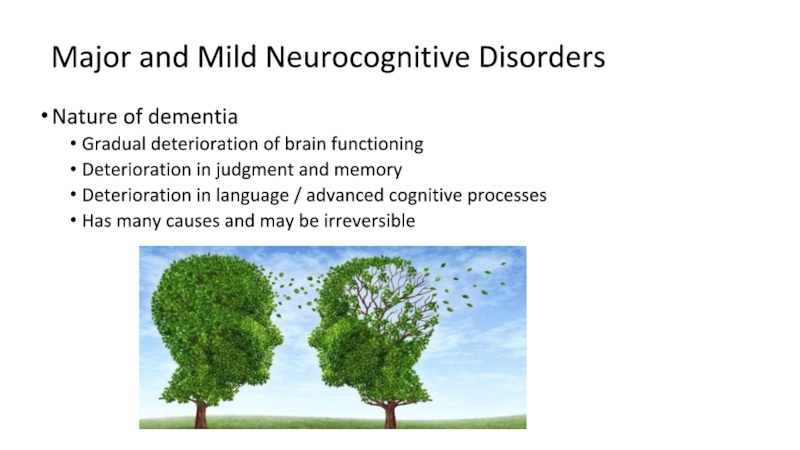
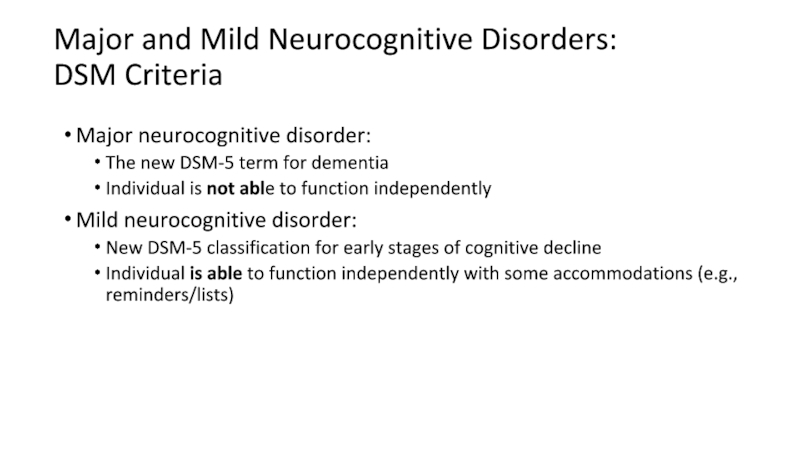



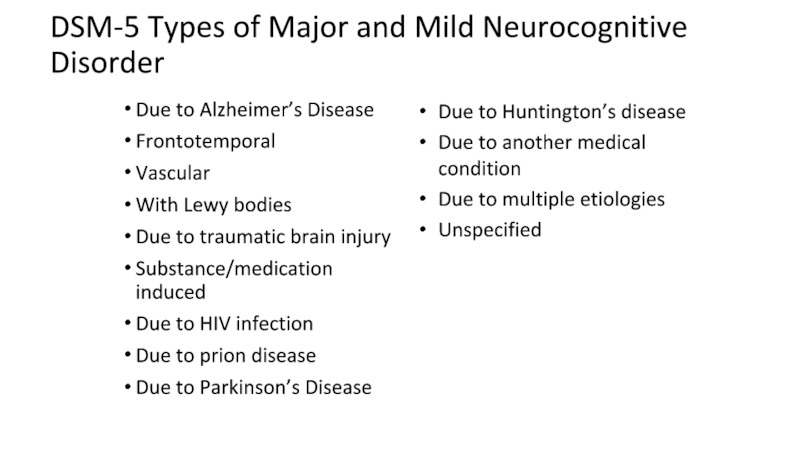

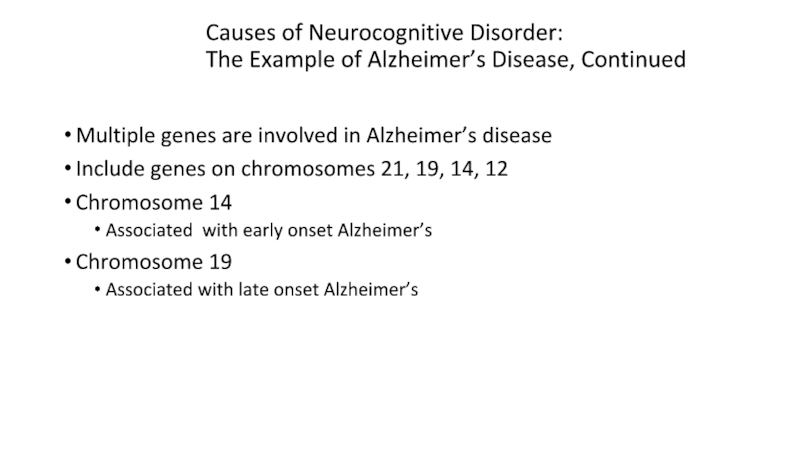
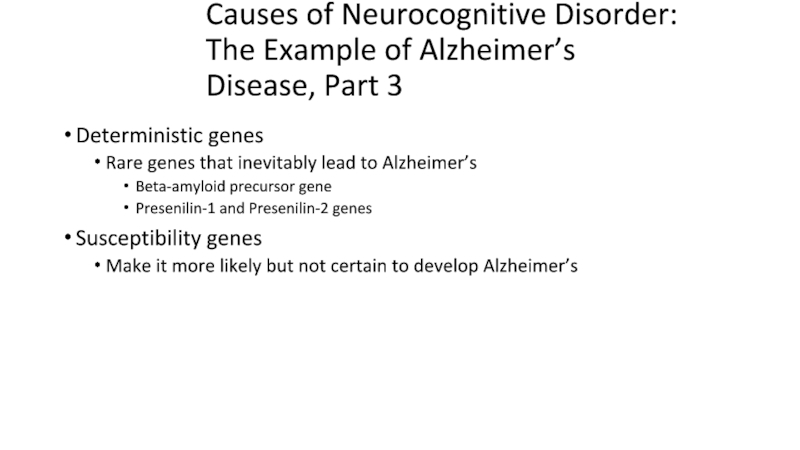


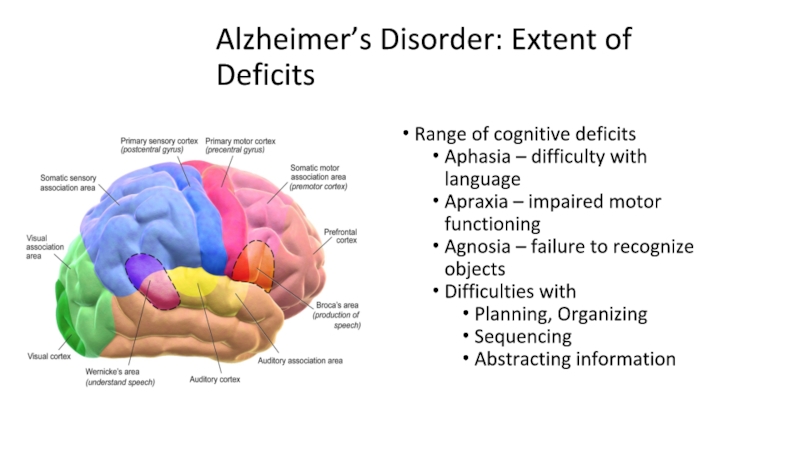

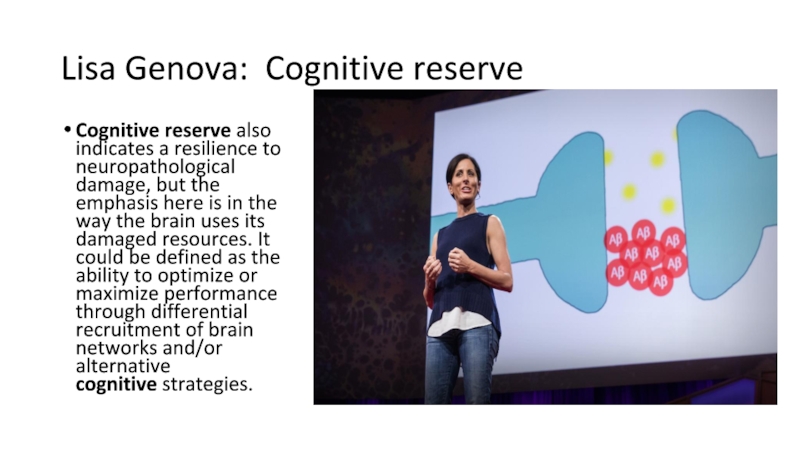

![Chapter 15 Neurocognitive Disorders Graph of Predicted Alzheimer’s Incidence[INSERT Figure 15.1 HERE, p. 548] Graph of Predicted Alzheimer’s Incidence[INSERT Figure 15.1 HERE, p. 548]](/img/tmb/4/355463/fe1edb4750100d413960696c2788e052-800x.jpg)
